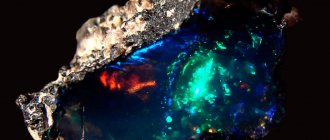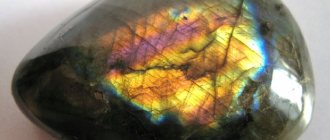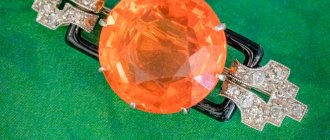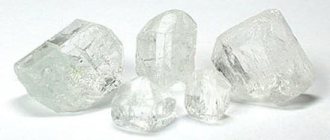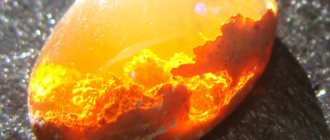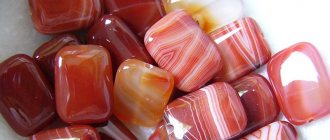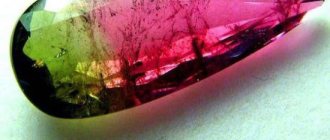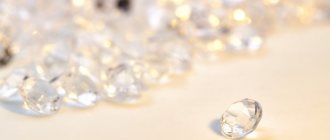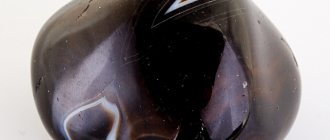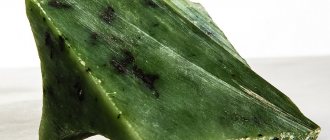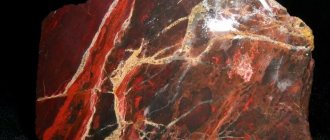Hello, friends! What do you know about white opal? Have you ever seen it up close, felt the pleasant coolness of its touch and do you know why it is called the stone of “deceptive dreams”?
Our acquaintance with the mineral took place recently. He was so impressed by the beauty and perfection of color combinations that we decided to delve into the study of its properties, characteristics and effects. You will be surprised, but such a delicate and elegant-looking pebble is as good as it is bad. The mineral really affects the behavior, well-being and life of the owner. It works wonders, causing unusual desires, helping to achieve goals, but under certain conditions. What do you need to know to get the most out of a stone and not become a toy in the hands of fate? Read on!
History and brief description of white opal
Elegant white opal has magical properties.
This gem has been known to people since ancient times. Its name itself comes from Sanskrit, in which it sounds like “upala”, which means “stone”. Pliny the Elder wrote about this mineral, calling its radiance similar to that of a carbuncle.
Despite the fact that opals are classified as semi-precious stones, these translucent crystals were extremely valuable back in Antiquity.
There is a legend about the stone of Nonius, a Roman senator who chose to go into exile rather than give Mark Antony his gem, decorated with opals. Among the gems that decorated the dress, there was one, the size of a hazelnut, of extraordinary beauty - it was the subject of a dispute among the patricians.
In Greece, it was believed that milky opal was able to reward its owner with the gift of becoming invisible. And the Vikings had a legend that the blacksmith Volunde created the stone from the eyes of his children, whom he killed. The Elder Edda says that if you peer into the depths of the crystal for a long time, you can see children's faces.
In ancient times, it was believed that opal owes its amazing iridescence to the water contained in it. This myth is partly true - the mineral, in addition to silicon dioxide, contains about 30% H₂O.
Synthetic opal
Synthetic opal
Scientists in many countries have learned to reproduce opals in laboratories. The Austrians were the first to create synthetic gems, and the Swiss were the next to distinguish themselves. These countries have introduced artificial opals in colors that do not exist in nature to the market.
Russia also has its own “craftsmen,” whose research centers are located in Novosibirsk and St. Petersburg. They, together with the Japanese and Chinese, produce synthetic gems from materials found in natural stones. The technology is strictly classified; the “particularly curious” are only told that in the laboratory conditions are created and processes similar to those that a stone experiences when being born in nature are reproduced. The only difference is that to obtain a full-fledged gem, scientists need not millions of years, but only one and a half to two years. Special opalescent glass can also be used to create imitations.
Synthetic opals cannot be criticized too much, because they are almost as beautiful and even more varied than natural ones. They are much harder and stronger, and have good resistance to heat. There are many of them, they are available to everyone.
But! Synthetics are energetically empty, which means they have absolutely no healing or magical properties.
Jewelers have a lot of tricks, for example, they also create:
- Doublets, that is, two-layer stones, with a plate of natural gem on top, and a black metal backing on the bottom, which makes the stone more impressive.
- Triplets are the same doublets, but supplemented with a top layer of quartz or glass, designed to protect the natural part from damage and give the product its shape.
Where and how is it mined?
Precious opals are found throughout the world, but are most often found in South America and Australia. There are deposits in small quantities in Russia - in Kamchatka, and in Ukraine.
But Australia is considered the birthplace of milky white opals. The most beautiful varieties of the mineral of the rarest and most beautiful shades are mined there. Interesting specimens are also found in the USA and Brazil.
Gems are formed as a result of volcanic processes and are a product of lava solidification, in which silicon dioxide is formed under the influence of sub-high temperatures.
As a result, opal deposits have the appearance of stalactites and stalagmites, protruding nodules and inclusions in volcanic rock, but not the shape of druses, as is the case with other gems.
Often the mineral is deposited in sedimentary rocks and fossils - the remains of animals and plants. Crystals can also fill cracks in rocks. Gems are mined in the open, except in cases where the deposits are located deep underground.
FORM AND SHINE
The most common form of opal is an oval-shaped cabochon, the length of which is 40% greater than the width and the height of which is approximately 60% of the width. In practice, these exact dimensions are very rare, because nature has created opals in a much greater variety.
| Oval opal | Pear opal | Free form | High cabochon |
Opals that are perfectly oval in shape automatically command a particularly high price because valuable material has been ground down to give this shape. Typically, 40 to 60% of the raw material is lost in order to give the opal its cabochon shape.
Ovals, pear-shaped and other regular shapes will be valued higher than free-form opals because more material has to be ground down to achieve them. The cabochon enhances the external perception and increases the perceived thickness of the color-forming area of the opal. This is why dome-shaped opals are more highly prized. Black opals do not always have a cabochon; more often they are flat on top or have a very small dome.
The quality of the stone cutter's work that we see on the finished stones can greatly affect the value of the opal, which must be polished to such an extent that there are no noticeable scratches or other defects.
Species diversity of opals
Opals are graded according to color scheme:
- white – almost transparent, with a slight bluish shimmer and bright tints;
- black is the rarest species; it includes specimens with intense coloring: bright blue, dark green, brown;
- fiery - this is the name given to gems of warm shades: pink, orange, honey, red; despite the weak play of light, when looking at such stones it looks like there is a fire burning inside;
- ordinary - nondescript translucent stones of white or milky color with a glossy sheen, also called porcelain;
- jirazol - this is the name given to blue-white crystals with a golden glow;
- hyalite is a transparent, colorless stone that begins to shimmer when light passes through;
- hydrophane - a cloudy white gem that begins to shimmer when immersed in water;
- chrysopal - greenish apple or bright emerald;
- Cacholong is white, opaque, and has a porous structure.
In addition, stones are also divided by origin. Thus, most of the black and white opals are mined in Australia. In Ethiopia, stones of warm colors are more common - honey-yellow, orange, red. Peru is characterized by blue-green minerals.
Some of the varieties of opal.
Colors and varieties
Opals are a huge group of different colors, intensity of brilliance, degree of transparency, hardness and the presence of mineral impurities.
Two main subgroups:
- Noble opals (precious stones) - have a beautiful color (milky white, yellowish, black, blue, yellow-red), they are always transparent or translucent.
- Ordinary opals (semi-precious stones) are colored in dull and dull tones or colorless, and can be transparent to varying degrees.
The most famous varieties are:
- Fire opals are transparent or translucent stones with a red-yellow color scheme. Some Mexican specimens show opalescence.
Fire opal
- Black opals - these include all varieties of dark tones, including dark brown and inky specimens.
Black opal
- Hydrophanes are porous stones that, when absorbing water, become transparent and display a play of colors.
Hydrophane water opal
- Boulders are a type of opal formed as a layer in the rock. The name translates as “boulder” or “cobblestone”.
Boulder opal
- Chrysopals (prasopals) are opaque specimens of an apple-green hue.
Chrysopal
- Wax opals have a waxy yellow color.
Wax opal
- Peruvian opals (blue Peruvian opals) - can have a blue, pink and bluish color, do not differ in color play, and are mined in Peru.
Blue Peruvian opal
- Girasoli are transparent stones, almost colorless, with a blue tint.
Opal Girasol
- Cacholongs (pearl opals) are a mixture of porcelain opal, quartz and chalcedony, opaque, milky white in color.
Cacholong
- Irisopals are a colorless or brownish type of opal mined in Mexico, characterized by a single-color tint.
Irisopal
- Wood opals - formed in the process of replacing wood with a mineral, can repeat the pattern of tree rings.
Wood opal
- Opal jasper samples - due to the high content of iron oxides, the stones are colored brown or red.
Opal Jasper
Physicochemical characteristics
The stone belongs to the quartz family and consists of silicon oxide hydrate and water (its content varies from 13 to 30%). This explains the high fragility of the gem: opal poorly resists temperature changes, the influence of chemicals, does not tolerate increased dryness, and is easily destroyed by mechanical stress.
Crystals often contain foreign inclusions, most often oxides of iron, aluminum, and magnesium. They appear in the pattern on the surface of the stone.
Medicinal properties
Even in ancient times, people began to use opals to heal various diseases. The mineral was applied to tumors and swelling to relieve inflammation. Today, lithotherapy has confirmed the healing properties of the stone.
Healers claim that the gem:
- improves hearing;
- normalizes the functioning of the digestive system;
- restores vision;
- strengthens the cardiovascular system;
- has a positive effect on the emotional background;
- stimulates brain activity.
In addition, opal is used as a diagnostic tool - during exacerbation of chronic diseases, even before symptoms appear, it changes color.
The mineral can be worn to improve hearing.
The magical properties of white opal
Even in ancient times, miraculous properties were attributed to the stone. It was believed that the gem contributed to the development of supernatural abilities in its owner.
The stone does not interact with everyone, but if it suits a person, it affects him in a variety of areas:
- reveals creative abilities;
- enhances intuition;
- increases performance;
- attracts good luck;
- helps in achieving the goal;
- protects from troubles.
It is believed that wearing a stone makes its owner kinder and cleaner. It is not for nothing that in ancient times opal was considered a symbol of purity.
Areas of use
The gem has been valued by magicians and healers since ancient times. And today it is widely used in esoteric practices and used in occult ceremonies.
He is also extremely revered by palmists. Even ancient priests and magicians endowed opal with the ability to protect the purity of the soul and clarity of mind. It is still used in rituals to remove damage and the evil eye.
In jewelry, jewelry with white opals is not very common, but true connoisseurs love rings, pendants, and gems with this wonderful stone.
In addition, the mineral is used in the manufacture of decorative items - vases, figurines, candlesticks, boxes. It is also used for interior decoration.
Talismans, amulets, amulets
For a long time, it has been noted that the gem has the ability to warn of dangers or diseases that threaten the owner. With impending troubles, the stone changes color and becomes cloudier. This property was widely used in the creation of amulets.
People of creative professions like to wear it as a talisman - it is believed that it stimulates the development of talents. For fishermen and hunters, the stone brings good luck in fishing, and protects travelers from dangers on the road.
Charms with white opal warn people from danger.
What zodiac signs is it suitable for?
The stone is not suitable for everyone. If it gives cheerfulness to some, then, on the contrary, it can make others feel blue. Before purchasing jewelry with this gem, you should definitely contact astrologers for advice.
Sagittarius
People born under this sign should avoid wearing the stone. It can increase their temper and even make them aggressive.
Capricorn
Not the best choice: the stone will develop even more stubbornness. But if the desire to own a gem is stronger, astrologers recommend that this sign wear fire opals rather than milky and white ones.
Aquarius
It is best to choose stones with a slight bluish tint and a bright play of light. They will help develop creative abilities.
Fish
Opal will help develop intuition and protect against diseases. Promotes the development of the best spiritual qualities.
Aries
Energetic Aries should not wear jewelry with this stone: it adversely affects their energy and depresses emotions.
Taurus
This is not the best solution for Taurus. The gem should not be worn too often, but can be used as a talisman for risky undertakings.
Twins
For Gemini, the mineral will help strengthen their financial situation and help solve financial problems.
Cancer
These representatives of the zodiac circle are recommended to wear jewelry with opal before important decisions. It sharpens intuition and attracts good luck.
a lion
You should not wear the gem too often. This can cause emotional exhaustion.
Virgo
For this sign, white opal will be the best decoration. It will help maintain health and clarity of mind.
Scales
The stone will help you find like-minded people. Promotes luck in endeavors and success in business.
Scorpion
For those born under this zodiac sign, the gem will relieve negative thoughts and protect them from despondency. Will help maintain health.
Combinations of white opal and other stones
It is best to combine gems with blue, blue and violet crystals in jewelry:
- amethyst;
- lapis lazuli;
- turquoise;
- onyx;
- beryl.
It is under no circumstances recommended to combine opals with jasper, garnet and ruby. You should not wear jewelry with diamonds and aventurine at the same time. But it is favorable to wear opal and amber together.
It is best to choose silver as a frame. The stone looks good in white gold and platinum.
Compatibility with other minerals
Opal pendant
Opal is a water gem, and accordingly, it has the best union with its fellow elements. The compatibility of opal with Earth stones will also be ideal - the unique properties of both in “team work” will manifest themselves to the maximum extent. Opals can and should even be combined with:
- Coral.
- Aquamarine.
- Hashenite.
- Euclase.
- Jade.
- Sarder.
- Melanitis.
- Emerald.
- Aventurine.
- Turquoise.
- Jasper.
You should not combine opal with air or fire stones in jewelry. In the first case, gems will conflict, creating negative vibrations for a person, in the second, they will simply “put out” each other, turning from magical stones into beautiful trifles.
Opal has negative compatibility with:
- Diamonds (diamonds).
- Rubies.
- Pyrope.
- Amethysts.
- Rock crystal.
- Hyacinth.
- Pomegranate.
- Chrysoprase.
What does the cost consist of?
The stone is interesting because when evaluating it, it is not the size in carats that is taken into account, but criteria such as:
- tone;
- brightness;
- transparency;
- drawing on the surface.
In addition, the following parameters also affect the cost of opal:
- play of light (opalescence) - in the most valuable specimens it can be seen from any angle;
- shape – preference is given to stones that do not require complex processing;
- presence of inclusions.
Whole gems with a minimum of foreign inclusions are most highly valued. Such stones are used for jewelry and in collections.
How to distinguish a real stone from a fake
Counterfeits of white gemstones are quite rare, although there are valuable specimens among them. Identifying natural white opal is not difficult. You need to keep some nuances in mind and know the features of the stone:
- Although the mineral does not have high strength, unlike glass, it will not leave cracks if it is acted upon mechanically. Try to lightly hit it on some surface; if the stone is damaged, it is a fake.
- Triplets and doublets (artificial analogues of the mineral) can be distinguished by their unnatural color, layered structure, and lack of opalescence effect.
- The natural mineral will not stick to the surface of the tongue. The synthesized opal will linger for a couple of seconds.
In the video, a natural Australian mineral:
Rules for wearing jewelry
The stone is highly fragile, so you need to treat it with care. When getting ready, you should put on jewelry last, after makeup has already been applied.
It is better to use perfume and eau de toilette in advance - opal is sensitive even to such influences. It is not advisable to wear products with stone if you are going to spend the evening in a stuffy or smoky, poorly ventilated room. You should avoid wearing the opal with other jewelry that could scratch it.
Opal jewelry in gold and silver should be worn with care to avoid damaging the stone.
Origin story
On all continents of our planet there are ancient legends in which opal played an important role. These stories are fascinating and frightening at the same time.
An interesting legend is preserved by ancient Greek myths that tell of the victory of the god Zeus in the war with the Titans. It is believed that multi-colored opals are divine tears of happiness that fell from heaven to earth. The ancient Greeks were sure that the power of the Zeus stone could endow a person with the gift of clairvoyance.
The Arabs believe in the ability of the mineral to protect from the influence of the elements and bad weather, considering the gem to be a child of lightning. India talks about the goddess of the rainbow, who was pestered by numerous fans. Running away from them, the girl fell, breaking into hundreds of multi-colored stones.
The main purpose of opal for centuries has been to bring good luck. However, history has captured the moments when the nugget became a participant in fateful events. Scandinavians are sure that opal is the creation of the blacksmith god, the material of which was children's eyes. The chronicles of the Middle Ages speak of many dark rituals performed with the help of a gem. In addition, the nugget served as poison - the mineral, crushed into powder, poisoned food.
Do you know that in 1829, after the publication of Walter Scott’s novel “Anna von Geyerstein”, opals ceased to be in demand for the next 20 years. This is due to the plot of the novel, in which the gem causes the death of the owner. A year later, I.V. Kireevsky presented Russia with the story “Opal”, after the publication of which the mineral for a long time acquired a reputation as a stone that brings misfortune.
One of the English monarchs, Edward VII, feared the influence of opal, ordering all the gems to be removed from the crown. Josephine, Napoleon's wife, laughed at this kind of prejudice. However, one day a gem with the beautiful name “Burning Troy” appeared in the house of a married couple, which caused the couple to separate.
Later, a legend appeared that this pebble simply disappeared into thin air. Jewelers had to get rid of stones, since no one wanted to buy jewelry with opals. The interesting thing is that the stone does not have a single meaning.
Translated from three different languages, the name “opal” is interpreted completely differently. In Latin the word means “Enchanting Gaze”, in Greek it means “vision of change”, and in Sanskrit it describes the meaning of “precious stone”.
Australian peoples consider opals to be traces of the Creator of the World, calling the stones “desert fire.” Today, the mineral is the officially recognized symbol of South Australia, as well as the local women's national basketball team.
Secrets of storage and care
The stone contains from 13 to 30% water, so it is necessary to ensure sufficient humidity in the room where the jewelry is stored. If the room is too dry, you can put a damp cloth in the box.
To prevent moisture from drying out, it is recommended to periodically treat the stone with a weak solution of glycerin.
You can wash jewelry only with the most delicate products. To clean heavy dirt, use a soft sponge or toothbrush.
Stone care
Since the gem is fragile, it requires careful handling when worn. You need to wash it with a soft brush in a weak soap solution, then rinse gently under running water, wrap it in a damp cloth and leave for several hours. Dry the opal in sunlight, the main thing is not to overexpose it so that it does not change its color or fade.
Do not allow gems to come into contact with any other detergent (except water and soap during cleaning). For storage, select suitable containers with walls lined with soft fabric. You need to put jewelry in the box after wrapping it in a soft rag.
White opal is a stone of amazing beauty. Despite its fragility and vulnerability to the environment, it is always popular among jewelry lovers. With careful care, the gem will delight the owner with its unique and delicate beauty for a long time.
Facts about White Opal
The unusually beautiful semi-precious stone was valued by monarchs. So, it was Queen Victoria's favorite gem. And the ancient Romans considered the stone precious, along with rubies, sapphires and diamonds.
The Peruvian Indians believed that opal was born from lightning that struck from the sky. This myth received original confirmation already in our millennium: opals were discovered in rock samples delivered from Mars.
This stone is considered alive - it has the property of aging. This is due to the fact that the mineral does not have a crystalline structure and is almost 30% water.
